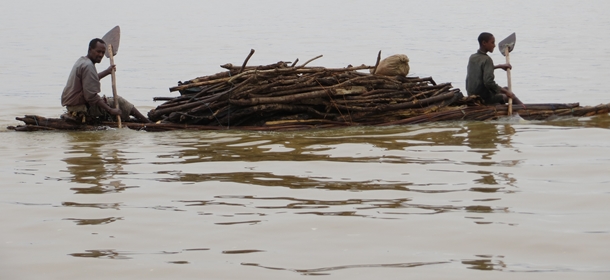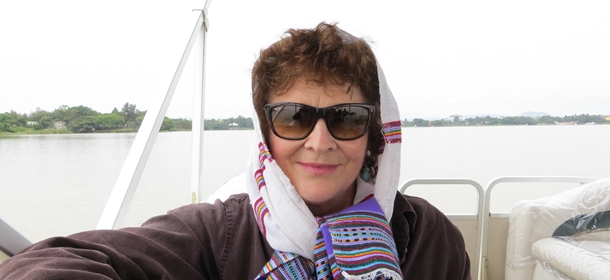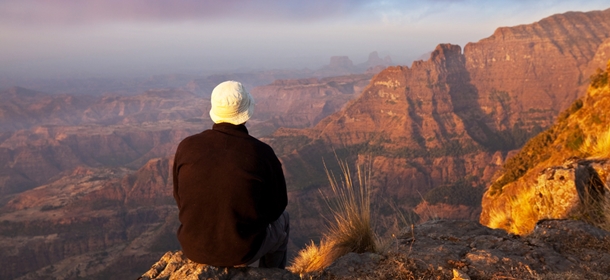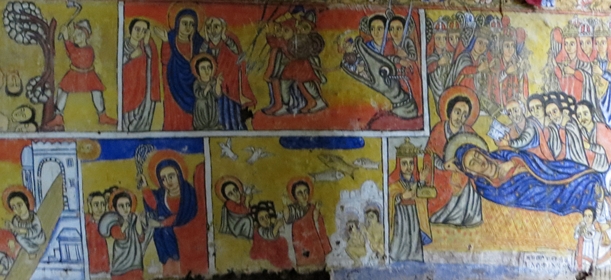In part two of the account of her recent tour of Ethiopia, Lily heads north to Lake Tana, the castles of Gonder and a spectacular trip into the stunning Simien Mountains.
Friday, 26th July.
Early start to the airport for Ethiopian Airlines flight departing 0720 to Bahir Dar. Armed guards boarded the coach at airport perimeter to check our passports before being allowed into the Terminal area. Melkam checked us all in for the flight and the service was smooth on board. Bahir Dhar by Lake Tana is a popular route for locals and tourists alike and for many itineraries on the Northern Historic Route, this is the starting point from Addis Ababa.
The well-defined historical circuit through Northern Ethiopia forms the core of the country’s tourist industry with about 90% of travellers to Ethiopia basing the bulk of their itineraries around this area. There is nothing in sub-Sahara Africa (and in a sense nothing in the world) that prepares the visitor for the wealth of historical and cultural treasures, both ancient and living, contained in Northern Ethiopia. Although I had read and been advised of the uniqueness of the area, I found myself constantly amazed and incredulous as the sights and experiences unfolded.
Arrived at 0820 and met by driver and comfortable coach (approx 20 seats). Set off for the short drive to the modern city of Bahir Dar is the standard first stop and is a bustling commercial centre set on the southern shores of Lake Tana, the largest body of water in Ethiopia and official source of the Blue Nile.
Bahir Dar forms the obvious base for boat trips to the multitude of atmospheric medieval Christina Orthodox monasteries dotted around the forested islands and peninsulas of Lake Tana, one of which we were planning to visit, later in the morning.
On road into Bahir Dar, the road traffic was very varied from cars, wagons, bicycles, mopeds, to hay carts with bales of hay pulled by donkeys which I found particularly fascinating coming from a farming background. This was our first experience of life outside Addis and seemed far removed from the big city life, but then I didn’t realise what was to come in the days ahead which would make Bahir Dar seem like a metropolis! We stopped at the Kuriftu Resort and Spa Hotel set on the shores of Lake Tana and had cups of Ethiopian coffee in the foyer while Melkom made final arrangements for our boat trip on the Lake to visit the Ura Kidane Mihret monastery on the Zege peninsula. Drove to the jetty where our private motor launch with upper deck awaited. Very comfortable and clean with pleasant ‘captain’. There are about 20 monastic churches on the islands and peninsulas of Lake Tana and we passed various ‘monastery’ islands including one ‘men only’ and another ‘women only’ on our way to the Zege Peninula. A variety of bird species including pelicans gave us passing interest as we motored up the lake and very interesting to see the traditional tankwa boats (long slim dugout canoes) heavily laden with long poles of wood heading southwards towards Bahir Dar presumably to market. Arrived at the jetty of the forested Zege Peninsula and walked about 2kms up through the forested track past banana plantations and local villages. Plenty of craft stalls on the way selling varied and attractive items from ethnic scarves to wooden icons and straw boats.
 Finally reached Ura Kidane Mihret which ranks not only as the most impressive of the southern monasteries but also the most frequently visited church on the lake. The circular church was built in the 16th century and the interior walls are covered in an incredible jumble of murals, painted between 100 and 250 years ago. We were fascinated by the subject matter of many of the paintings, the colourful frescoes depicting biblical scenes and the history of the Ethiopian Orthodox Church many in very graphic detail. The colours were very bright being so well preserved in the dim light of the church. The monastery is an integral part of the local community.
Finally reached Ura Kidane Mihret which ranks not only as the most impressive of the southern monasteries but also the most frequently visited church on the lake. The circular church was built in the 16th century and the interior walls are covered in an incredible jumble of murals, painted between 100 and 250 years ago. We were fascinated by the subject matter of many of the paintings, the colourful frescoes depicting biblical scenes and the history of the Ethiopian Orthodox Church many in very graphic detail. The colours were very bright being so well preserved in the dim light of the church. The monastery is an integral part of the local community.
Walked back to the jetty running the gauntlet of the vendors and their enticing wares – I think we all bought some momento of our visit!!
Sailed back south to Bahir Dar with a small detour to the where the Blue Nile enters Lake Tana. We didn’t have time to visit the Blue Nile Gorge that day so this was the closest we would come to the Blue Nile. Another example of how Melkom did his very best not to disappoint the group!
 Our bus was waiting to collect us and off we went back to the Kuriftu Resort and Spa for lunch. Excellent lunch with yummy soup and delicious fish and tasty pudding. Good service in pleasant surroundings overlooking the lake. Had a short site visit and saw a spacious room with balcony and the essential lake view. Big curved swimming pool, landscaped gardens. We all agreed a very nice relaxing place to stay.
Our bus was waiting to collect us and off we went back to the Kuriftu Resort and Spa for lunch. Excellent lunch with yummy soup and delicious fish and tasty pudding. Good service in pleasant surroundings overlooking the lake. Had a short site visit and saw a spacious room with balcony and the essential lake view. Big curved swimming pool, landscaped gardens. We all agreed a very nice relaxing place to stay.
Loaded up once again and off on the road north to Gonder which runs parallel with Lake Tana for over half the journey of 185 kms (four hours). Fascinating sights along the way… such varied landscape of hills, lush pastures, red soil areas then black soil areas , herds of cattle and goats but the people were most striking of all! Very fine looking mostly in traditional dress and the men invariably armed with a stout stick … for defence as well as support! Passed fields being ploughed by traditional methods with a pair of oxen and wooden plough.
At 1900, finally arrived at the Goha Hotel set on a hill looking down on the city of Gonder. This hotel is part of the government owned Ghion chain. Location is excellent but unfortunately the rooms we were given varied from ok to very poor. I was lucky in that although my bathroom was very basic, I had a modern flat screen Sony television and the room was spacious and comfortable. No water on the second night but we had water delivered to the room. Internet in main lobby and restaurant was well appointed and food although not the best we had, was tasty. The staff were very pleasant and happy to help in any way.
A short background to the history of Gonder which was the 17th century capital of Ethiopia and one of the main tourist attractions on the northern historical circuit, best known for its castles and palaces. A pleasant city with a friendly laid back almost countrified atmosphere Population is about 250,000 and is the fourth largest city in Ethiopia.
Juxtaposed against the distinctive Gonderine architecture, much of the modern town centre dates from the Italian occupation of 1936-41 and hints of Art Deco and other pre-war European styles can be detected in many of the run-down buildings that line the central Piazza.
It is also the base for trips to the Simien Mountains.
Saturday, July 27th
After a good night’s sleep, up at 0600, breakfast and away from the hotel at 0715 heading up into the Simien Mountains. It had rained heavily the previous night but blue sky was peeping through the misty clouds as we headed up into the mountains. Saturday is Market Day in Ethiopia and a constant stream of people on the road heading to the nearest town/village with their goods to sell from cattle/goats/sheep/horses to donkeys laden goods like planks of wood/material/baskets. People walking for miles just to get to market which is both a commercial and social event.
Big open areas of land with fields of horses, mules, donkeys, goats, sheep, cattle. Animals generally in good condition.
It is like looking at a patchwork quilt as there are also many areas with much smaller fields planted with different types of crops showing different colours.
Architecture of houses varies – round hut = kitchen and square hut= house. Wooden houses mostly made of wooden poles. Reminded me of tobacco barns!
Situated about 100kms north of Gonder, the Simien Mountains are one of Africa’s largest ranges, studded with at least a dozen peaks topping the 4000 metre mark. The entire range was designated a National Park in 1969 then a UNESCO World Heritage Site in 1979. Onwards into the park with truly spectacular scenery. Stopped at Kosoye viewpoint (2,900 metres) for a panoramic view- WOW!
 The distances are as follows: 100 kms from Gonder to Debark on paved road then a single dirt road runs through the park. We travelled about 22 kms on this road.
The distances are as follows: 100 kms from Gonder to Debark on paved road then a single dirt road runs through the park. We travelled about 22 kms on this road.
Architecture of houses varies – round hut = kitchen and square hut= house. Wooden houses mostly made of wooden poles. Reminded me of tobacco barns!
Three of Ethiopia’s endemic large species are resident in the Simiens. The gelada baboon is the most common of these with an estimated population of 7,000 often seen congregating in grazing herds of up to 400 individuals. By contrast the Ethiopian wolf is very rare in the mountains and more commonly seen further south in the Bale Mountains. The wahlia ibexwas poached close to extinction but its numbers are now on the rise with an estimated population of about 650 individuals.
Other animals seen very occasionally are klipspringer, bushbuck and spotted hyena. The common jackal is often seen around camps.
We saw the endemic black headed siskin on several occasions and lammergeyer birds of prey soaring above the escarpments. Also thick billed ravens, Ruppells vultures and black storks.
We stopped at the park headquarters of the Simien Mountains National Park in Debark to pay park fees, and collect our two armed guides who travelled with us into the mountains.
Very busy town, constant stream of roadside life… all headed for big market at Debark. People sitting by roadside wrapped in blankets…
Travelled on dirt road through the market area – incredible for people watching and out of town climbing higher.
After leaving Debark at about 3,100 metres, we had major road problem – grader machine was fixing the road and there was a major traffic queue including three tourist buses, several heavily laden lorries and five 4 x 4’s. So it meant all passengers had to get out of their transport and walk over the problem area and hope that their respective vehicles managed to navigate the treacherous road.
I looked around and it was like being on top of the world and reminded me of Lesotho!
Eventually the grader opened the road and our Dinknesh bus made it to the higher level and we all jumped back on. Continued on our way and at about 3260 metres luckily came across a troop of about 80 gelada baboons who were grazing on a large area of grassland by the road. This was an amazing experience as the baboons were entirely unconcerned about our presence although if we did get too close, they hissed and bared their teeth! Several generations living together including youngsters riding jockey style on their mothers’ backs’. Great photo opportunities… at no charge!
We went onto another view point but unfortunately the weather ‘closed in’ with mist and rain. However, Melkam and Daniel, our driver, prepared coffee (by the side of the bus) over a primus stove accompanied by biscuits which was very welcome indeed. A group of children selling baskets etc. set up ‘shop’ a few yards away and they were strictly disciplined by one of our guides.
From there we headed off to Simien Lodge for lunch. Unfortunately by this time the track was very muddy and we got stuck but after three attempts at reversing down and taking a run at the slope from left then right, we finally managed to navigate the slippy slope (well done, driver Daniel) and arrived at the Lodge with very good appetites. Lunch delicious and they even lit a big log fire in the dining room to warm us up. Site inspection showed us very attractive rooms with magnificent views.
Back to Debark and another road problem due to the heavy rain since we’d navigated this stretch of bad road about 2 hours earlier. As we went through the market area still on the dirt road, got bogged down and instantly various ‘helpers’ came to our rescue. Lots of shouting, laughing, pushing and panting before we got clear – Melkam rewarded the main man who shared the birr with his ‘team’!
Back to tarmac road and headed out of the mountains to Gonder. It was about 4pm when we arrived back in Gonder and we went straight to the Imperial Castle Compound of Gonder.. also known as the Camelot of Africa. This UNESCO World Heritage Site which contains six castles, a complex of connecting tunnels and raised walkways is unique in its design and character.
The most impressive castle within the enclosure is the original built by Fasilidas around 1640 and partially restored during mid-20th century and later 1999-2002 with UNESCO funding. A stunning place to visit and we could have spent much longer here to appreciate the history.
There was a wedding taking place in the grounds which was very special to see this amazing site being used for modern day ceremonies.
Off to the Tayew Hotel located in central part of town for a site visit. Superior room with large balconies near to the Castle historical area – modern, spacious, smart bathroom. A good place to stay for clients so handy for the Main Street and balconies ideal for viewing the surrounding area and the hustle and bustle of the street scene. Wi-Fi at the hotel.
From here to the Florida Hotel on the outskirts of town – lovely views over the hills. Modern hotel, attractive lobby area, fresh and welcoming. Rooms very pleasant with every facility. Wi-Fi at the hotel. The Florida Hotel was probably the highest grade of hotel we saw in Gonder.
Arrived back at the Goha hotel about 6.30pm. Melkom had organised dinner at a local restaurant which gave regular cultural shows which was very enjoyable and gave an insight into the food/drink/folklore of the country.
